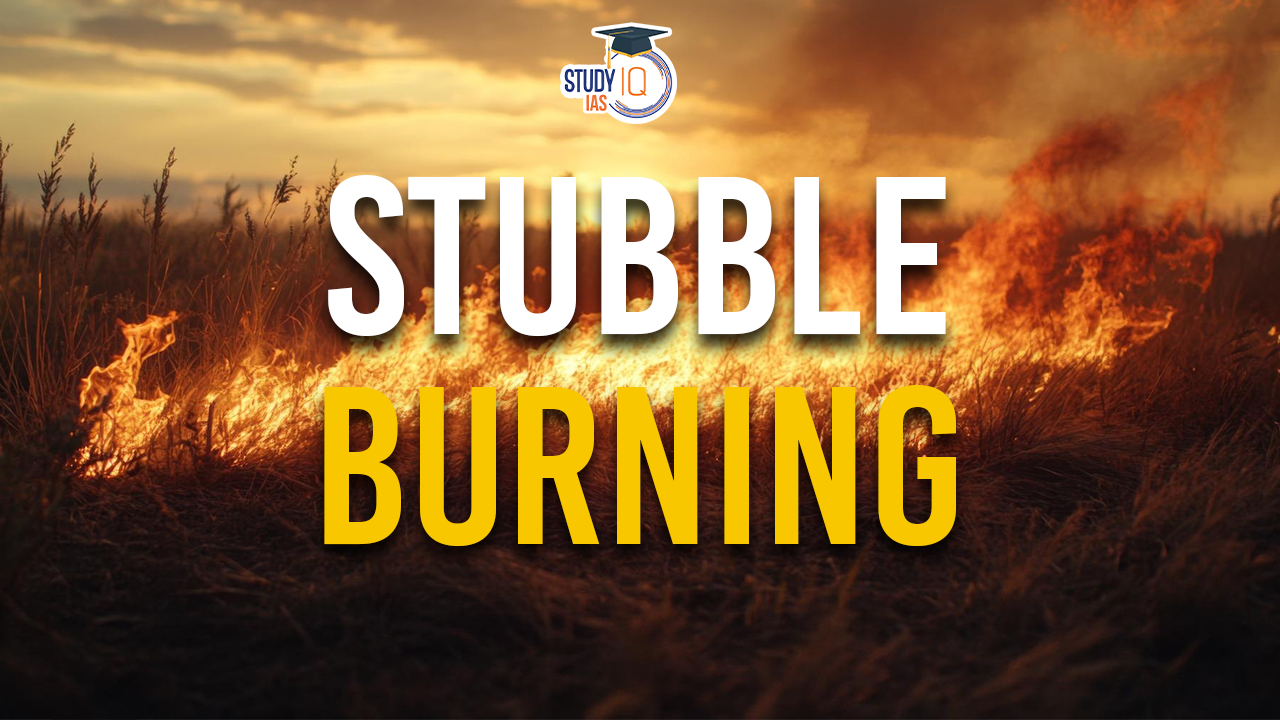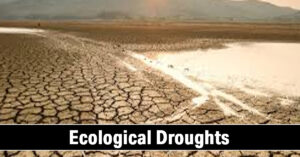Table of Contents
Context: According to a latest study stubble burning contributes only about 14% of PM2.5 in Delhi-NCR and is not the primary source of particulate matter in the region.
Key Highlights of the Study on Stubble Burning
The study utilized field measurements, airmass trajectories, and particle dispersion and chemical transport model simulations.
Declining Stubble Burning Events
- From 2015 to 2023, stubble-burning events in Punjab and Haryana declined by over 50%.
- In 2023, stubble-burning events in Punjab decreased by 31% and in Haryana, by 37%.
Air Quality in Delhi-NCR
- Despite a significant decline in stubble burning, 5 concentrations in Delhi-NCR remained stubbornly high and in the “very poor” to “severe” category during the winter months (December to February) since 2016.
- Factors like stagnant winds, lower mixing heights and temperature inversions in the winter months contribute to high pollution levels in Delhi-NCR.
- This indicates that sources beyond stubble burning play a significant role in air pollution.
Role of Wind and Weather
- While strong winds can carry pollution from stubble burning, weather conditions like low winds and temperature inversions play a more important role in trapping and keeping pollutants in the air.
- Local emissions from vehicles, industries and other sources are also a significant cause of pollution.
Local Sources of Pollution
- The study found that 5 levels and CO (carbon monoxide) concentrations increase at night in Delhi, suggesting that pollution comes from local sources such as vehicles, biomass burning and fossil fuel burning.
- If stubble burning were the main cause, CO levels would remain stable at all times, but they increase at night, pointing to local pollution as a major contributor.
Local Contributions
- Transport sector is the largest contributor to PM2.5, accounting for 30%.
- Local biomass burning contributes about 23%, while construction industry and road dust contribute 10%.
- Cooking and industrial activities contribute about 5-7%.
- Stubble burning contributes only about 13% to PM2.5 levels, primarily in October-November.
What is Meant by Stubble Burning?
- Stubble (parali) burning is a method of removing paddy crop residues from the field by setting the straw stubble fire to sow wheat from the last week of September to November.
- Paddy stubble burning is most prevalent in the Indo-Gangetic plains of Punjab, Haryana, and Uttar Pradesh.
| Facts |
|
Why is Stubble Burning Practised?
- It is done mainly to prepare the land quickly for the rabi crop (such as wheat), as the time window between paddy harvesting and wheat sowing is very short, typically around 2 to 3 weeks.
- Punjab has the highest incidence of paddy stubble burning, followed by Haryana, while Uttar Pradesh leads in wheat stubble burning.
- Farmers find it the cheapest method to clean fields after harvesting.
Impact of Stubble Burning
Air Pollution
It is a major cause of air pollution in North India, especially in Delhi and surrounding regions.
- It contributes to the deterioration of the Air Quality Index (AQI) due to the release of harmful pollutants like:
- Carbon Monoxide (CO)
- Methane (CH₄)
- Carcinogenic Polycyclic Aromatic Hydrocarbons
- Volatile Organic Compounds (VOCs)
- These pollutants disperse in the atmosphere forming thick blankets of smog, which severely affects air quality and public health.
- Example: Punjab and Haryana are responsible for up to 40% of the pollutant load in Delhi during the peak season.
Soil Fertility
- Burning stubble destroys essential soil nutrients, making the soil less fertile.
- It also leads to the loss of useful microbes that contribute to soil health.
Heat Penetration
The intense heat generated during stubble burning penetrates the soil, causing erosion, loss of moisture, and degradation of soil quality.
Causes Behind Stubble Burning And Its Persistence
- Awareness programs designed to engage residents in addressing the public health crisis face delays.
- Many crop residue management machines are often unavailable when needed by farmers.
- There is no efficient system for transporting straw from fields to power plants.
- The pollution crisis is complex and requires sustained efforts for gradual improvement.
- The Union government’s Commission for Air Quality Management (CAQM) has not been effective as a mediator.
- Traditional belief (burning crop residue will restore nutrients back to the soil) of the farmers is prevalent.
Initiatives to Reduce Stubble Burning
- The State Governments of Punjab, National Capital Region (NCR) States and the Government of National Capital Territory of Delhi (GNCTD) have developed detailed monitorable action plans based on the framework by the Commission for Air Quality Management (CAQM) to tackle the problem of air pollution.
- The Punjab government has proposed a cash incentive of ₹2,500 per acre to farmers who refrain from burning paddy straw.
Way Forward
- Subsidising Equipment: Under the Crop Residue Management (CRM) scheme, baler machines are offered at subsidised rates.
- Facilitating Loans: With the growing industrial demand for crop residue as a raw material for fodder, ethanol production, and use in thermal plants, providing easily accessible loans for purchasing balers could be beneficial.
- Adopting Enhanced Crop Varieties: Utilising improved seed varieties, especially those of short-duration rice and wheat, can be beneficial.
- For example: varieties like Pusa Basmati-1509 and PR-126 not only mature rapidly but also enhance soil quality.
- Implementing Bio-Waste Decomposition: Agricultural microorganisms in bio-waste decomposers enhance the Feed Conversion Ratio (FCR).
- Example: Pusa-Bio Decomposer a fungi-based liquid solution that can soften hard stubble to the extent that it can be easily mixed with soil in the field to act as compost.


 International Aryan Summit 2025: Celebra...
International Aryan Summit 2025: Celebra...
 Ecological Droughts in India: Causes, Im...
Ecological Droughts in India: Causes, Im...
 Elderly in India: Population, Challenges...
Elderly in India: Population, Challenges...




















